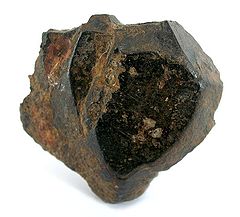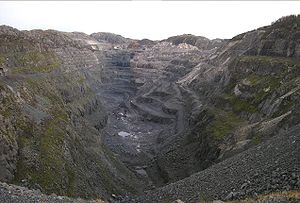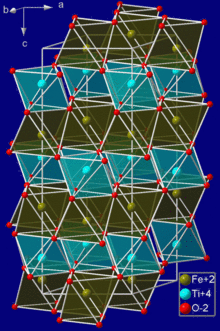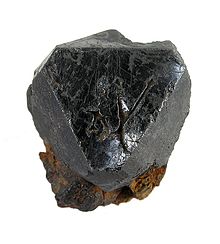- Ilmenite
-
Ilmenite 
Ilmenite from Miask, Ilmen Mts, Chelyabinsk Oblast', Southern Urals, Urals Region, Russia. 4.5 x 4.3 x 1.5 cmGeneral Category Oxide mineral Chemical formula iron titanium oxide, FeTiO3 Strunz classification 04.CB.05 Dana classification 04.03.05.01 Identification Color Iron-black; gray with a brownish tint in reflected light Crystal habit Granular to massive and lamellar exsolutions in hematite or magnetite Crystal system Trigonal Rhombohedral 3 Twinning {0001} simple, {1011} lamellar Cleavage absent; parting on {0001} and {1011} Fracture Conchoidal to subconchoidal Tenacity Brittle Mohs scale hardness 5–6 Luster Metallic to submetallic Streak Black Diaphaneity Opaque Specific gravity 4.70–4.79 Optical properties Uniaxial (–) Birefringence Strong; O = pinkish brown, E = dark brown (bireflectance) Other characteristics weakly magnetic References [1][2] Ilmenite is a weakly magnetic titanium-iron oxide mineral which is iron-black or steel-gray. It is a crystalline iron titanium oxide (FeTiO3). It crystallizes in the trigonal system, and it has the same crystal structure as corundum and hematite.
Contents
Distinguishing features
Ilmenite is commonly recognised in altered igneous rocks by the presence of a white alteration product, the pseudo-mineral leucoxene. Often ilmenites are rimmed with leucoxene, which allows ilmenite to be distinguished from magnetite and other iron-titanium oxides. The example shown in the image at right is typical of leucoxene-rimmed ilmenite.
In reflected light it may be distinguished from magnetite by more pronounced reflection pleochroism and a brown-pink tinge.
Ilmenite is weakly magnetic, with a weak response to a hand magnet.
Mineral chemistry
Ilmenite most often contains appreciable quantities of magnesium and manganese and the full chemical formula can be expressed as (Fe,Mg,Mn,Ti)O3. Ilmenite forms a solid solution with geikielite (MgTiO3) and pyrophanite (MnTiO3) which are magnesian and manganiferous end-members of the solid solution series.
Although there appears evidence of the complete range of mineral chemistries in the (Fe,Mg,Mn,Ti)O3 system naturally occurring on Earth, the vast bulk of ilmenites are restricted to close to the ideal FeTiO3 composition, with minor mole percentages of Mn and Mg. A key exception is in the ilmenites of kimberlites where the mineral usually contains major amounts of geikielite molecules, and in some highly differentiated felsic rocks ilmenites may contain significant amounts of pyrophanite molecules.
At higher temperatures it has been demonstrated there is a complete solid solution between ilmenite and hematite. There is a miscibility gap at lower temperatures, resulting in a coexistence of these two minerals in rocks but no solid solution. This coexistence may result in exsolution lamellae in cooled ilmenites with more iron in the system than can be homogeneously accommodated in the crystal lattice.
Altered ilmenite forms the mineral leucoxene, an important source of titanium in heavy mineral sands ore deposits. Leucoxene is a typical component of altered gabbro and diorite and is generally indicative of ilmenite in the unaltered rock.
Paragenesis
 Tellnes opencast ilmenite mine, Sokndal, Norway
Tellnes opencast ilmenite mine, Sokndal, Norway
Ilmenite is a common accessory mineral found in metamorphic and igneous rocks. It is found in large concentrations in layered intrusions where it forms as part of a cumulate layer within the silicate stratigraphy of the intrusion. Ilmenite generally occurs within the pyroxenitic portion of such intrusions (the 'pyroxene-in' level).
Magnesian ilmenite is indicative of kimberlitic paragenesis and forms part of the MARID association of minerals (mica-amphibole-rutile-ilmenite-diopside) assemblage of glimmerite xenoliths. Managaniferous ilmenite is found in granitic rocks and also in carbonatite intrusions where it may also contain anomalous niobium.
Many mafic igneous rocks contain grains of intergrown magnetite and ilmenite, formed by the oxidation of ulvospinel. Ilmenite also occurs as discrete grains, typically with some hematite in solid solution, and complete solid solution exists between the two minerals at temperatures above about 950°C.
Titanium was identified for the first time by William Gregor in 1791 in Ilmenite from the Manaccan valley.
Ilmenite is named after the locality of its discovery in the Il'menski Mountains, near Miass, Russia,
Consumption
Most ilmenite is mined for titanium dioxide production. Finely ground titanium dioxide is a bright white powder widely used as a base pigment in paint, paper and plastics.
North America and Europe together consume about 50% of the world's titanium dioxide production. Demand by India and China is growing rapidly and may eventually surpass Western consumption.
World consumption rises approximately 5% to 8% per annum, with demand growth most strongly centred in Asian economies. World demand in 2004 was 335,000 tonnes of TiO2 units, representing about 2.4 million tonnes of ilmenite.
Ilmenite is converted into titanium dioxide via the sulfate process. Sulfate process plants must utilise low-vanadium ilmenite, as vanadium is a penalty element. Titanium dioxide pigment can also be produced from higher titanium feedstocks such as rutile and leucoxene via a chloride acid process.
Raw ilmenite is refined by decreasing the iron content. Carbon (anthracite) is used to convert some of the iron oxide in the ilmenite to metallic iron. The products of this process are molten iron (pig iron) and a slag rich in titanium. A related process is the Becher process.
Ilmenite sand is also used as a sandblasting agent in the cleaning of diecasting dies.
Production
Estimated titanium ore production
in thousands of tons for 2005
according to U.S. Geological Survey[3]Country Production Australia 1,140 South Africa 952 Canada 809 China 400 Norway 380 United States 300 Ukraine 220 India 200 Brazil 130 Vietnam 100 Mozambique (750) Madagascar (700) Sénégal (150) Other countries 120 Total world 4,800 Australia was the world's largest producer and exporter of ilmenite ore in 2005–2006, with 1.1 million tonnes, followed by South Africa (952Kt), Canada (809Kt), China (~400Kt) and Norway (380Kt).[4]
Development of large mineral sands operations in Sénégal, Côte d'Ivoire, Madagascar[5] and Mozambique will see extensive supplies of ilmenite, rutile, zircon and leucoxene reach world markets in coming years. This is reflected in the table at right in parentheses. This additional supply of ilmenite and titanium feedstock, approximating 1.5 million tonnes per annum, is in excess to world demand growth of 350Kt per annum.
Although most ilmenite is recovered from heavy mineral sands ore deposits, ilmenite can also be recovered from layered intrusive sources colloquially known as "hard rock titanium" ore sources.
Mining operations
The world's largest open cast ilmenite mine is the Tellnes mine located in Sokndal, Norway, and run by Titania AS (owned by Kronos Worldwide Inc.), a hard rock ilmenite mine, which produces most of Norway's 380,000t of ilmenite production. In Karhujupukka located in Kolari, northern Finland there is a magnetite-ilmenite ore at around 5 million tons. The ore contains about 6.2% titanium.
The Balla Balla magnetitite-iron-titanium-vanadium ore deposit, in the Pilbara of Western Australia, contains ~600 million tonnes of magnetite-ilmenite cumulate ore horizon grading 58% Fe, 14% TiO2 and 0.8% V2O5, one of the richest magnetite-ilmenite ore bodies in Australia. The ore deposit is scheduled to be mined in mid-2009, to produce in excess of 480,000t per annum of ilmenite product.
Major mineral sands operations include:
- Richards Bay in South Africa.
- Coburn, WIM 50, Douglas, Pooncarrie in Australia
- Iluka Resources have other operations in Australia including Murray Basin, Eneabba and Capel.
- The Kerala Minerals & Metals Ltd(KMML), Indian Rare Earths(IRE),VV Mineral in India.
- QIT Madagascar Minerals, a Rio Tinto Group subsidiary, recently began production at a mineral sands operation in Madagascar expected to produce 750,000t per annum of ilmenite, potentially expanding to 2,000,000t per annum in future phases.
Lunar ilmenite
Ilmenite has been found in Moon rocks, and is typically highly enriched in magnesium similar to the kimberlitic association. In 2005[6] NASA used the Hubble Space Telescope to locate potentially ilmenite-rich locations. This mineral could be essential to an eventual Moon base, as ilmenite would provide a source of iron and titanium for the building of structures and essential oxygen extraction.
References
- ^ http://webmineral.com/data/Ilmenite.shtml Webmineral data
- ^ http://rruff.geo.arizona.edu/doclib/hom/ilmenite.pdf Mineral Handbook
- ^ "U.S. Geological Survey" (PDF). http://minerals.usgs.gov/minerals/pubs/commodity/titanium/timinmcs06.pdf. Retrieved 2006-03-07.
- ^ USGS
- ^ "Malagasy mine brings Aids threat". BBC. November 2, 2005. http://news.bbc.co.uk/2/hi/programmes/crossing_continents/4397702.stm.
- ^ http://news.bbc.co.uk/1/hi/magazine/4177064.stm How to set up a moonbase. NASA
Oxide minerals SimpleMixedAeschynite-(Y) · Armalcolite · Betafite · Euxenite · Freudenbergite · Haggertyite · Ilmenite · Keilhauite · Latrappite · Perovskite · Polycrase · Zimbabweite · Zirconolite · ZirkeliteSilicate minerals Other Chlorite · Dickite · Halloysite · Hectorite · Illite · Ilmenite · Imogolite · Kaolinite · Montmorillonite · Nacrite · Nontronite · Palygorskite ·
Saponite · SepioliteCategories:- Iron minerals
- Titanium minerals
- Oxide minerals
- Ilmenite group
- Trigonal minerals
Wikimedia Foundation. 2010.



